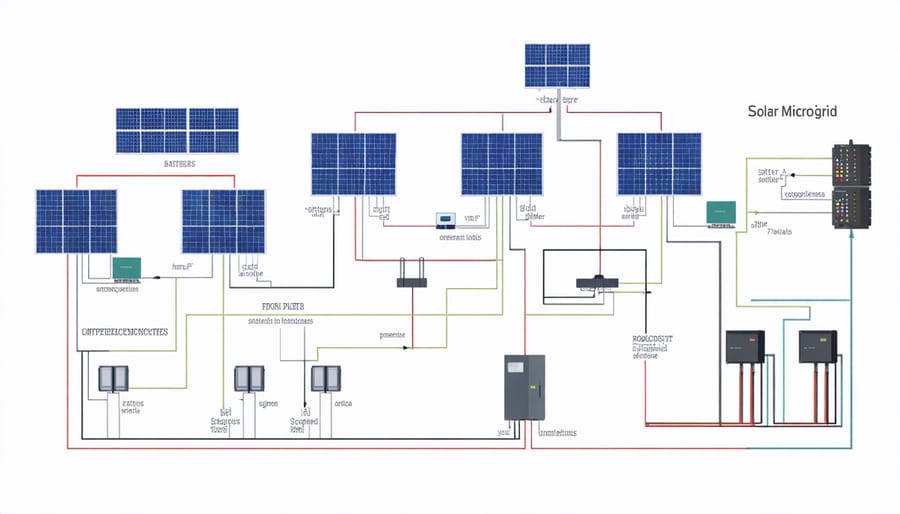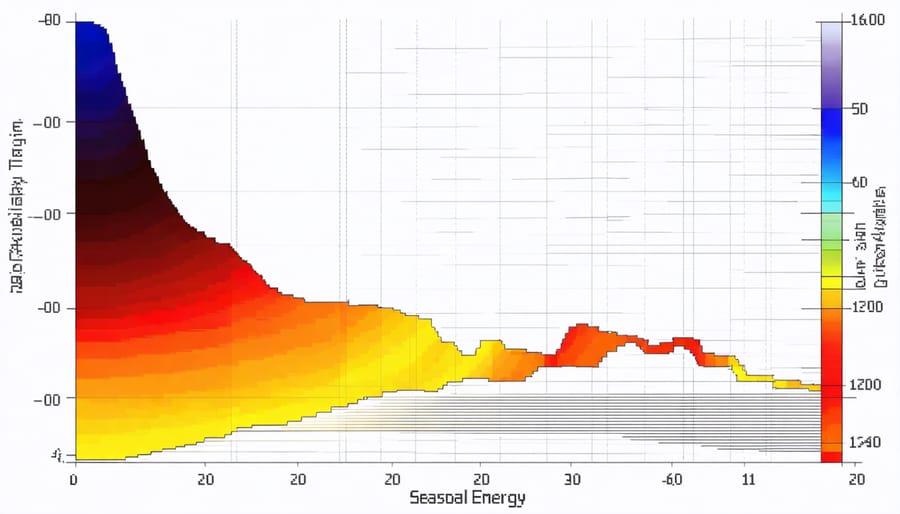Smart Microgrid Modeling Revolutionizes Remote Solar Performance

Modeling microgrids demands precision engineering and sophisticated simulation tools to revolutionize how we design and optimize distributed energy systems. As mobile microgrid solutions become increasingly vital for European energy independence, accurate modeling serves as the cornerstone for successful implementation. Advanced computational techniques now enable engineers to predict system behavior under various scenarios, from sudden load changes to extreme weather events, ensuring optimal performance and reliability.
Modern microgrid modeling incorporates real-time data analytics, machine learning algorithms, and dynamic load balancing to create resilient power networks that seamlessly integrate renewable sources with traditional infrastructure. This sophisticated approach allows project managers to optimize system components, reduce operational costs, and maximize energy efficiency before physical deployment. By simulating multiple scenarios and testing various configurations virtually, organizations can significantly reduce implementation risks while ensuring their microgrids meet specific local energy demands and sustainability goals.
The integration of advanced modeling tools with practical engineering expertise enables unprecedented accuracy in predicting system performance, making microgrid solutions more accessible and reliable for communities across Europe. This technological convergence represents a crucial step toward achieving energy autonomy and environmental sustainability in our increasingly distributed power landscape.
Understanding Microgrid Modeling Fundamentals
Key Components of Solar Microgrids
A well-designed solar microgrid comprises several essential components that work together to ensure reliable power generation and distribution. At the heart of the system lies the solar array, consisting of photovoltaic panels that convert sunlight into electricity. Understanding these components is crucial for successful off-grid solar system design and implementation.
Energy storage systems, typically in the form of advanced battery banks, store excess power for use during non-productive hours or cloudy days. The power conversion system, including inverters and charge controllers, manages the flow of electricity and converts DC power from solar panels into AC power for standard appliances.
A sophisticated control system serves as the brain of the microgrid, optimizing power distribution and managing the transition between grid-connected and island modes. This intelligent controller ensures system stability and efficient operation through real-time monitoring and automated decision-making.
Protection devices and safety mechanisms safeguard the system against electrical faults and overloads, while distribution infrastructure delivers power to end-users. Modern microgrids often incorporate smart meters and monitoring equipment to track performance and enable preventive maintenance.

Modeling Parameters and Variables
In microgrid modeling, several key parameters and variables must be carefully considered to ensure accurate system representation. Load profiles form the foundation, encompassing both daily consumption patterns and seasonal variations typical across European regions. These profiles need to account for peak demand periods, base loads, and potential future growth.
Energy generation sources require detailed modeling of their output characteristics, including solar panel efficiency curves, wind turbine power curves, and battery storage capabilities. Environmental factors such as solar irradiance levels, temperature variations, and local weather patterns significantly impact system performance and must be integrated into the model.
Economic parameters play a crucial role, incorporating equipment costs, maintenance expenses, and potential revenue streams from energy trading. Grid interaction variables, including import/export capabilities and tariff structures, need careful consideration for grid-connected microgrids.
System constraints such as voltage limits, power quality requirements, and equipment ratings must be accurately represented. Additionally, control system parameters, including response times, decision-making algorithms, and communication protocols, are essential for modeling the microgrid’s operational behavior and ensuring reliable performance under various scenarios.
Advanced Optimization Techniques
Load Forecasting and Management
Load forecasting plays a crucial role in microgrid modeling, enabling system operators to anticipate and manage energy demand effectively. By analyzing historical consumption patterns, weather data, and seasonal variations, advanced forecasting algorithms can predict energy requirements with remarkable accuracy. This predictive capability is particularly valuable for European businesses and industries looking to optimize their energy independence and sustainability goals.
Modern load management systems employ sophisticated techniques to balance demand across different time periods. These systems consider factors such as peak usage times, available renewable energy resources, and storage capacity to create optimal operation schedules. For instance, in commercial settings, smart load scheduling can shift non-critical operations to periods of high solar generation, maximizing the use of renewable energy while reducing grid dependency.
The integration of artificial intelligence and machine learning has revolutionized load forecasting accuracy. These technologies can process multiple data streams simultaneously, accounting for variables such as building occupancy patterns, industrial production schedules, and even local events that might impact energy consumption. This enhanced precision helps system operators make informed decisions about energy storage, generation capacity, and grid interactions.
For residential microgrids, load management often focuses on optimizing household consumption patterns. Smart home systems can automatically adjust energy usage based on solar production forecasts, battery levels, and electricity prices. This intelligent approach to demand management helps homeowners maximize self-consumption of their solar energy while maintaining comfort and convenience.
Success in load forecasting and management requires regular monitoring and adjustment of prediction models to maintain accuracy and reliability. As consumption patterns evolve and new technologies emerge, these systems must adapt to ensure optimal microgrid performance.

Energy Storage Integration
Energy storage integration plays a crucial role in microgrid modeling, serving as the backbone for system reliability and performance optimization. Battery storage systems, in particular, require sophisticated modeling approaches to accurately predict their behavior and interaction with other microgrid components.
Modern modeling techniques incorporate multiple parameters including state of charge (SOC), depth of discharge (DOD), charging efficiency, and temperature effects. These factors significantly influence battery performance and longevity, making their accurate representation essential for system optimization.
Advanced storage integration models also consider hybrid solutions, combining batteries with thermal storage systems to enhance overall system efficiency. This integrated approach allows for better energy management and cost optimization, particularly relevant for European installations where seasonal variations significantly impact energy production and consumption patterns.
The modeling process typically includes:
– Dynamic charge/discharge characteristics
– Degradation patterns over time
– Temperature-dependent performance variations
– Integration with renewable energy sources
– Power flow optimization algorithms
For optimal results, storage modeling must account for both short-term power balancing needs and long-term seasonal storage requirements. This dual-focus approach ensures system resilience while maintaining economic viability.
Recent innovations in artificial intelligence and machine learning have enhanced storage modeling accuracy, enabling better prediction of storage behavior under various operating conditions. These advanced techniques help system designers optimize storage capacity, improve discharge strategies, and maximize the economic benefits of energy storage integration within microgrids.
Real-World Implementation

European Success Stories
Europe’s commitment to renewable energy has yielded remarkable success stories in microgrid modeling and implementation. The Isle of Eigg in Scotland stands as a pioneering example, where advanced modeling techniques enabled the creation of a reliable hybrid system combining wind, solar, and hydroelectric power. This sophisticated modeling approach has helped the island achieve 95% renewable energy independence since 2008.
In rural Portugal, remote community solar installations have transformed energy accessibility through precise microgrid modeling. The Azores project particularly demonstrates how detailed simulation tools predicted energy demand patterns, leading to optimal solar panel placement and storage system sizing. This resulted in a 40% reduction in diesel generator usage and significant cost savings for local communities.
The Swedish village of Simris showcases another triumph in microgrid modeling. Using advanced software tools, engineers created a fully renewable energy system that accurately forecasts weather patterns and energy consumption. The model’s precision enabled the community to achieve 100% renewable energy supply for over 140 households during significant portions of the year.
These success stories highlight how sophisticated modeling tools have become instrumental in designing efficient, reliable microgrids across Europe. The projects demonstrate that careful planning and accurate simulation can lead to sustainable, cost-effective energy solutions for communities of all sizes.
Implementation Challenges and Solutions
Implementing microgrid modeling solutions often presents several key challenges that require careful consideration and strategic planning. One common obstacle is data accuracy and availability, particularly when modeling existing infrastructure or predicting renewable energy generation patterns. To address this, organizations can implement robust monitoring systems and leverage historical weather data specific to European regions.
Integration complexity poses another significant challenge, especially when combining multiple energy sources and storage systems. The solution lies in adopting standardized communication protocols and ensuring compatibility between different system components through comprehensive testing phases.
Resource constraints, both in terms of expertise and computing power, can limit modeling capabilities. Organizations can overcome this by investing in cloud-based modeling platforms and partnering with experienced consultants who understand local energy regulations and requirements.
Regulatory compliance and grid code requirements vary across European countries, making standardization challenging. Success depends on maintaining close collaboration with local authorities and staying updated with evolving energy policies.
The dynamic nature of energy demand patterns can complicate accurate modeling. Implementation teams can address this by incorporating machine learning algorithms that adapt to changing consumption patterns and seasonal variations. Regular model calibration and validation ensure continued accuracy and reliability.
To minimize these challenges, organizations should adopt a phased implementation approach, starting with basic models and gradually increasing complexity as expertise and understanding grow. This strategy allows for learning and adjustment while maintaining operational stability.
Future Developments
AI and Machine Learning Integration
Artificial Intelligence and Machine Learning are revolutionising microgrid modeling by enhancing prediction accuracy and system optimization. These advanced analytics tools process vast amounts of historical performance data, weather patterns, and energy consumption trends to create more reliable forecasting models.
In European markets, AI-powered microgrid models are particularly valuable for managing the intermittent nature of renewable energy sources. The algorithms can predict solar generation patterns with unprecedented accuracy, considering local weather variations and seasonal changes specific to different European regions.
Machine Learning algorithms continuously improve their accuracy through iterative learning, adapting to new data patterns and system behaviors. This dynamic approach enables better demand response strategies and more efficient energy distribution within the microgrid network.
Key benefits of AI integration include real-time optimization of energy flows, predictive maintenance scheduling, and automated fault detection. For instance, smart algorithms can anticipate potential system failures before they occur, reducing downtime and maintenance costs.
The implementation of neural networks and deep learning models has shown particular promise in handling complex microgrid scenarios. These sophisticated tools can process multiple variables simultaneously, from energy prices to weather forecasts, enabling more precise load balancing and energy trading decisions.
For European businesses and homeowners, this translates to more reliable energy supply, reduced operational costs, and improved return on investment from their microgrid installations.
Smart Grid Connectivity
The future of microgrid modeling lies in its seamless integration with smart grid technologies, creating a more resilient and efficient energy ecosystem. As European energy networks evolve, smart grid connectivity enables microgrids to communicate and coordinate with the broader power infrastructure, optimizing energy distribution and consumption patterns.
Advanced monitoring systems and IoT sensors now allow microgrids to respond dynamically to changing conditions, from weather patterns to energy demand fluctuations. This real-time adaptability ensures optimal performance while maintaining grid stability. The integration of artificial intelligence and machine learning algorithms further enhances this capability, enabling predictive maintenance and automated load balancing.
For European businesses and communities, smart grid connectivity opens new opportunities for energy trading and sharing. Prosumers can participate in local energy markets, selling excess power when available and purchasing it when needed. This creates a more democratic and sustainable energy landscape, where small-scale producers contribute meaningfully to the grid’s overall stability.
The implementation of standardized communication protocols across Europe is making it easier for different microgrid systems to interact effectively. This interoperability is crucial for creating a unified energy network that can support the continent’s ambitious renewable energy goals while ensuring reliable power supply for all connected users.
Looking ahead, smart grid connectivity will play a vital role in achieving Europe’s carbon neutrality targets, enabling more efficient integration of renewable energy sources and supporting the transition to a sustainable energy future.
Microgrid modeling has emerged as an indispensable tool for optimizing remote solar installations across Europe, offering a strategic advantage in the pursuit of sustainable energy solutions. Through accurate simulation and analysis, stakeholders can confidently design, implement, and manage solar systems that deliver reliable power while maximizing return on investment.
The benefits of incorporating microgrid modeling into solar projects are clear and compelling. From reducing operational risks through precise load forecasting to enabling smarter resource allocation, this approach helps ensure project success from conception to implementation. For European businesses and communities, particularly those in remote locations, these models provide the foundation for energy independence while supporting broader sustainability goals.
As we advance towards a more renewable-powered future, the role of microgrid modeling will only grow in importance. The technology’s ability to optimize system performance, predict maintenance needs, and facilitate grid integration makes it an essential component of modern solar installations. For project stakeholders, embracing these modeling tools means better decision-making, improved system reliability, and enhanced energy efficiency.
We encourage European energy professionals and decision-makers to adopt microgrid modeling as a standard practice in their solar projects. The investment in proper modeling pays dividends through optimized system design, reduced operational costs, and increased energy security. As the renewable energy landscape continues to evolve, those who leverage these advanced modeling capabilities will be best positioned to succeed in their sustainable energy initiatives.
Leave a Reply